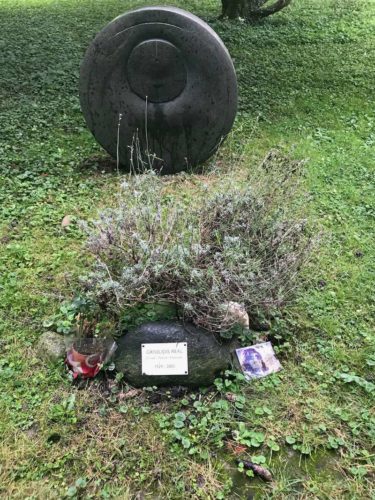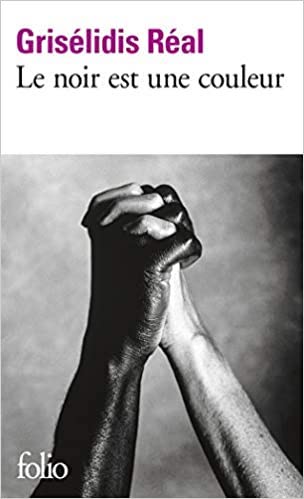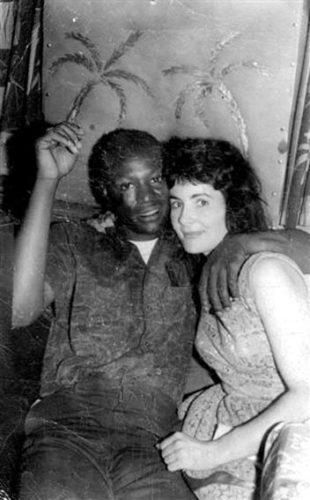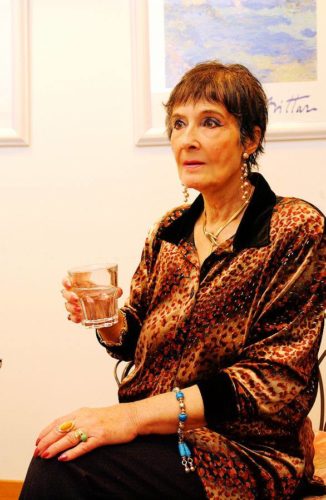Black is a colour, by Grisélidis Réal: writer, painter, sex worker
In this post I share why, besides being a wonderful book, Black is a colour is such an important book to me.
I practice Linguistic Empathy and I expect you to do the same. Please bear with me if my English is not perfect. Read the Italian version here.
Grisélidis Réal: writer, painter, sex worker. I squint and bend over to the plaque on the round, dark stone grave, because I’m not sure I’ve read that right.

I’m at the Cimitière des Rois, the most prestigious cemetery in Geneva. Today is the day I decided to discover something new in my host city. In the past, in other countries, I explored with friends. Here I do it alone, for many reasons. And if it seems silly to you that a cemetery can help you penetrate your host culture, read on.
It is a rainy day, the lawn and the graves – each different, some truly artistic – are humid, and this makes reading the epitaphs difficult. I was not wrong, though. The one of Ms Grisélidis Réal says that she was a writer, painter, sex worker.
Among the many illustrious names of this famous city cemetery, I had not heard hers. Nor had I seen it in the list you find on several websites that explain how important this place of eternal rest is.
I’ll find out why later. Many had opposed to relocate Grisélidis Réal to one of the best-known cemeteries in Geneva. After all, what place does a prostitute have next to illustrious names like that of Jorge Luis Borges, Argentine writer and philosopher, Jean Piaget, famous psychologist and pedagogue, and even the theologian and reformer Calvino?
She definitely has one. But to understand why, you need to dig a little into her story, her character and her work. Driven by my innate curiosity towards human stories, I immediately got to work. And the first thing I discovered is that this lady had been an expat. Wikipedia states that she was born in Lausanne but had lived in Alexandria in Egypt and Athens, before moving to Germany, where her career as a sex worker began.
My antennas immediately stood up. If a human story contains the element of expatriation, I feel overwhelmed by an irresistible attraction, by a hot wave equal to the one we all feel when dealing with our passions.
 Grisélidis Réal was a writer in her own right. She is the author of several works that are highly regarded. Black is a colour (I could not find any translation in English for it, so I simply translate the title) seems to be her most famous. And there my antennae rose again.
Grisélidis Réal was a writer in her own right. She is the author of several works that are highly regarded. Black is a colour (I could not find any translation in English for it, so I simply translate the title) seems to be her most famous. And there my antennae rose again.
As my Expatclic literary tea friends know, reading in French has always been tiring for me. Although I speak and write it well, like Spanish, reading it has always discouraged me – too many accents and diphthongs, I always felt I had to put too much concentration on the syllables, thus being unable to let the text penetrate me as it happens with other languages.
I told myself that this could be an opportunity. Reading the book of a Swiss expat woman who spent the last years of her life in my current host city, and in French, the language in which she wrote it.
So I ordered it. And then I devoured it. Despite the diphthongs and accents. And I was very happy because I don’t know how much the Italian translation has managed to convey the complexity of the feelings and situations that Grisélidis describes.
The book concentrates on a brief period of her life, between her running away from Geneva, in the sixties, and her arrest for possession and sale of marijuana in Munich, where Grisélidis had settled after various adventures in Germany, with the two youngest of her four children, and her partner Bill, whom she had managed to get (it is not clear how lawfully) out of an asylum.

Bill was an African-American with very dark skin and huge feet. Grisélidis makes no secret of her passion for dark-skinned men. She will have many as lovers, friends and customers. And every time it is an ode to pleasure, to black, smooth skin, its scent of ginger and cinnamon. But also an ode to freedom, because Grisélidis delivers her story with a spontaneity and honesty that make even more intense the terrible situations of misery and violence into which she had fallen.
She takes us into a world made of hunger, deceptions, precariousness, filth, theft, violence, a lot of violence, by her partner Bill but also by her clients, some of them real perverts who force her into things that weak stomachs will struggle to bear.
Perpetually on the run from someone – the police, his partner, violent clients, demanding renters – Grisélidis manages to build solid and reliable relationships in all this misery. She tells (and always thanks, with a deep and genuine sense of gratitude) of her friendships among the gypsies who hosted her for a long time in a dilapidated caravan that seemed to her like paradise. Or of her colleagues and neighbors in one of the many accommodations where she practiced that profession which, later on, when she returns to the Geneva from where I am writing this post, she will define as “an art, a humanism, and a science“.
Black is a colour also takes us into a piece of history, that of the reconstruction of Germany by the United States. It takes us to smoky bars full of blues, to the most squalid parts of the city, and into the heart of incredible characters, in a kaleidoscope that contains the most touching humanity and the bleakest perversion.
It is the intertwining of the history of an era with the free and nonconformist life of Grisélidis, told with a sparkling and optimistic style, which makes this book unique, and warmly recommended.

Grisélidis devoted the last part of her life to the fight for the rights of sex workers. What she calls “her revolution” began by claiming the right to freely choose that profession, which she will define as “a revolutionary act”, “an activity that alleviates human misery and has its grandeur” (source: https: // fr. ulule.com/griselidis-real/). In 1982 she was one of the founders of Aspasie, an association in defense of the rights of sex workers, which is still active today and hosts, among other things, a huge archive of documents of various kinds on international prostitution created by Grisélidis herself.
I researched and read with interest the controversy surrounding the funerary stone that the daughter of Grisélidis ordered to Jo Fontana, a sculptor from Geneva, and which represents a female belly. The conservative Genevans who did not consider it appropriate to have her buried in the Cimitière des Rois, could just not accept a sculpture of such impudence!
And now you understand why when you move to a new place, you should never neglect or underestimate anything. If I hadn’t decided to visit that cemetery that day, I would hardly have discovered that a woman of this magnitude has linked part of her destiny to the same city I am living in, has followed the same roads and looked at the same lake. And this partly shapes my relationship with the city. Because a city is made up of all the people who live or have lived there, and who in some way have left their mark on it. All of them. Also a writer, painter, sex worker.
